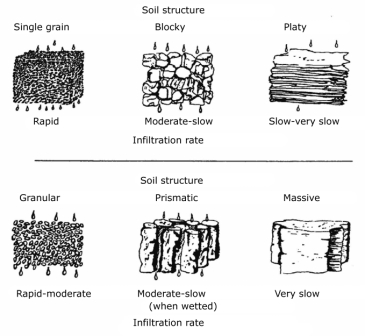We’ve had quite a bit of discussion this past week on the FaceBook page regarding Kelly Norris’s article in Fine Gardening on dealing with clay soils. While Kelly’s article mainly addressed selecting plants for heavy soils, there was a side-bar on cultural approaches to dealing with clays; including the standard advice to avoid adding sand to clays. This advice has been around for years. The first time I recall hearing it was from Dr. Carl Whitcomb when I took his Arboriculture class nearly 30 years ago (Fall 1984 to be exact). The rationale that is usually given is that adding sand to clay is the essentially recipe for concrete. Technically, of course, this is not entirely true since making concrete also requires cement. Nevertheless, trying to amend a clay soil with sand can lead to more problems than it solves. The fundamental issue is not that clay + sand = concrete. After all, there are plenty of highly productive soils in nature that have various ratios of sand and clay and they don’t form concrete. The bigger issue is that tilling a clay soil (which you’d have to do to incorporate added sand) leads to a loss of soil structure.
So, what is soil structure? Soil structure is a physical property of soil that describes its relatively ability to form aggregates. Unlike soil texture, which can be quantified as percent sand, silt, and clay; structure is a qualitative soil physical property. Common examples of soil structure are granular, platy or blocky.

While we usually think of clay as a negative thing (“Geez Jim, my wife just told me you have clay, I am so sorry…”); a well-structured clay soil can have excellent properties for plant growth. Well-formed clay aggregates (referred to as ‘peds’) in a granular soil can function very much like larger soil particles in terms of water movement and drainage. Soil structure is one of those things you have to experience to understand. About the best description I can come with is that peds in a well-structured granular soil often have the consistency and texture of Grape Nuts cereal.
There are also soils out there that are sometimes referred to a ‘structureless’ soils. These include single-grained soils and massive soils. Single-grained soils are essentially pure sand. In West Michigan these occur near Lake Michigan and are often called ‘blow sands’. We have several seedling nursery operations in these areas. Since there is no clay these soils have almost no nutrient-holding capacity – growers have to manage their fertility almost as it were a soilless system like a hydroponic or aeroponic system. The advantage of growing in these soils is it makes lifting bare-root seedlings easy. Massive soils, on the other hand, are very dense soils where particles do not show any evidence of aggregation. Repeated tillage can result in loss of structure and a soil (or portions of the soil) may show attributes of a massive soil including crusting or formation of hardpan. The example below shows how structure (indicated by % aggregation) is lost through repeated cultivation.

Effect of soil tillage on soil structure. Source (Greacen 1958, Australian J. Ag. Res. 9:129-137).
What can be done to improve or preserve structure? This is a case where less is often better. Natural processes such as freeze-thaw cycles and the action of earthworms and other invertebrates work to loosen soil and create aggregates. The tips in the Norris article (avoid overworking soil and adding organic matter) are essentially the same advice I would give.
Why does a 3 year pasture have less aggregation than a 10 year pasture? Is ‘pasture’ referring to an uncultivated field after intensive cultivation?
The Asian Jumping Worm arrived in my neighborhood this year, and I am watching my carefully tended 30+ year no-till soil disintegrate and collapse. What now? How will my blueberries grow without organic matter?
Topdress with organic matter. That’s how it naturally is incorporated.